Samsung Galaxy S 4 Review - Part 1
by Brian Klug on April 24, 2013 12:01 AM ESTDisplay
We wrote about how we suspected that SGS4 would go to a 5-inch 1080p SAMOLED display just after CES. Turns out that was spot on, as the SGS4 includes a 5-inch 1080p Full HD SAMOLED panel, the latest in Samsung's AMOLED roadmap. Samsung's naming stays true, and there's no Plus tacked on at the end, so we get another non-RGB stripe subpixel geometry with SGS4. The last few Samsung AMOLED variants we've seen have had different subpixel grids, and the one on the SGS4 is possibly the most interesting to date. There's still a bias toward more green subpixels than blue or red, this isn't an RGB stripe at all, but instead of the previous RG,BG layout we see this offset pattern with green on one line, then blue and red on another line. Interestingly enough the blue subpixel appears to be a square, and red and green appear to be circles, with the difference in area possibly offsetting the luminous efficiency of each material. Whatever the reason (Samsung has never been official or forthcoming any of these subpixel patterns each time they've changed them) it's present on the SGS4.
At this size however I have to admit that I find the pursuit of the subpixel geometry more of an educational one than something which affects users. While I could occasionally see it on the SGS3, I definitely do not see it on SGS4. The subpixels are now small enough that whatever the pattern, it all looks like a homogenous light-emitting surface, which was the goal after all. I could bring up the visual acuity discussion again but just trust me that it's small enough to not be visible even with actually perfect (not legally perfect, which is different) vision.
So resolution is great and up to par with all the other LCD-bearing flagships this year, lack of RGB stripe notwithstanding. There's that remaining question about brightness, contrast, outdoor visibility, and of course calibration and the saturation issue that has persisted with AMOLED from generation to generation.
On the brightness front, the SGS4 includes dynamic contrast functions that cannot be disabled and change as a function of what is being displayed. There's an "auto adjust screen tone" checkbox under display but don't let that fool you, that doesn't disable dynamic contrast, just white point. Under screen mode are the mDNIe toggles we've seen on countless other previous Samsung Android phones with AMOLED panels, only here we notice something interesting. There have always been four toggles as long as this option has existed, only what's different is now, one of them is named "Professional photo." Reviews of other regional variants of the SGS4 have included the same button but marked "Adobe RGB." Oddly enough it seems that the North American versions at least have this renamed for some reason, but undoubtedly the function is the same. Many speculated that this is now a toggle for some full CMS (Color Management System) which "fixes" the inherent color space issues with AMOLED and oversaturation that occurs when looking at sRGB content on such devices. Unfortunately, I can confirm that my initial suspicions that this is just a continuation of the mDNIe (lite) settings from previous generation is in fact correct. I reverse engineered what I could of these settings from both kernel messages while changing the toggles, and looking at the kernel sources. Turns out that 'Professional photo' mode is actually the 'Natural' mode renamed from previous versions.
So the question was whether the color space or white point actually does change with this mode enabled. I ran the SGS4 through our display tests in each of the modes and think the full color space plot tells the story. The sanest of them all really ends up being the strangely-named 'Movie' mode. Professional photo gives the big gamut with a white point closer to 'Movie,' which is to say around 7000K, but it doesn't fundamentally change the still-present oversaturation or color management issue that exists in Android with these wide gamut displays. Most users admittedly don't care however and just see "bright" colors. Theres' an Auto mode as well which the device ships with that basically has a matrix of mDNIe settings for targeted applications (for example the Gallery, Browser, Video playback) and so forth get settings, which you can see in the kernel.
| CalMAN Display Comparison | ||||||||||||
| Metric | iPhone 5 | iPhone 4S | HTC One X | SGS3 | Samsung Galaxy Note 2 | Google Nexus 4 | HTC Droid DNA | HTC One | SGS4 | |||
| Grayscale 200nits Avg dE2000 | 3.564 | 6.162 | 6.609 | 4.578 | 5.867 | 7.686 | 6.738 | 5.391 | 7.511 | |||
| CCT Avg (K) | 6925 | 7171 | 5944 | 6809 | 7109 | 8506 | 8108 | 8118 | 7020 | |||
| Saturation Sweep Avg dE2000 | 3.591 | 8.787 | 5.066 | 5.460 | 7.986 | 8.517 | 5.856 | 3.365 | 7.823 | |||
| GMB ColorChecker Avg dE2000 | 4.747 | 6.328 | 6.963 | 7.322 | 8.185 | 7.531 | 6.687 | 4.656 | 7.440 | |||
In the "Movie" mode things are better controlled than the Note 2 on the GMB color checker card test, which is the most important one for me. White point is also no longer the crazy 8000K that we saw before, 7000K is commendable for Samsung at this point. Keep in mind that maximum brightness changes in each mode as well as we effectively clamp things, I measured a maximum of 319 nits in Dynamic mode, 311 nits in Movie mode, and 255 nits in Standard, for example.
Running the display at maximum brightness for too long will also get you into an overheating or thermal protection mode as well, which we've seen on countless other AMOLED variants. Most of the time I suspect users will run on Auto brightness however which keeps brightness down to a much lower level to save battery and prevent that from becoming a problem.
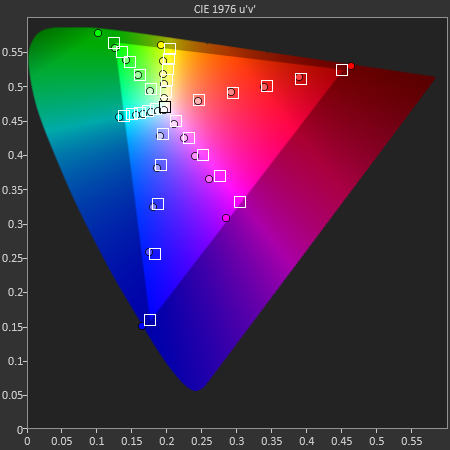
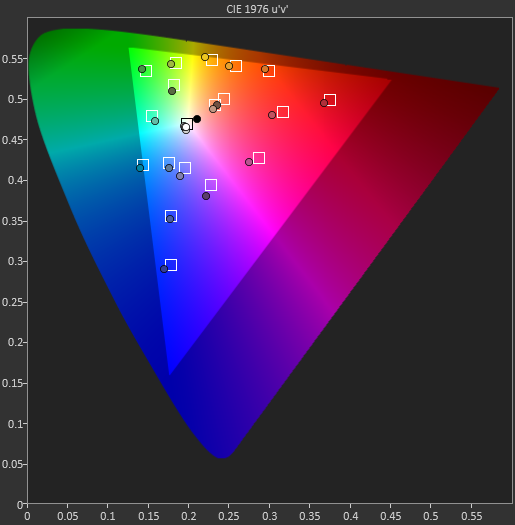
Because "Movie" was the closest to sRGB of all the modes, I selected it for the actual results that I'll present in the table. Admittedly this mode does tighten things up a bit, but it still isn't perfect and I'd still like to see Samsung do something to reign this in at some point.


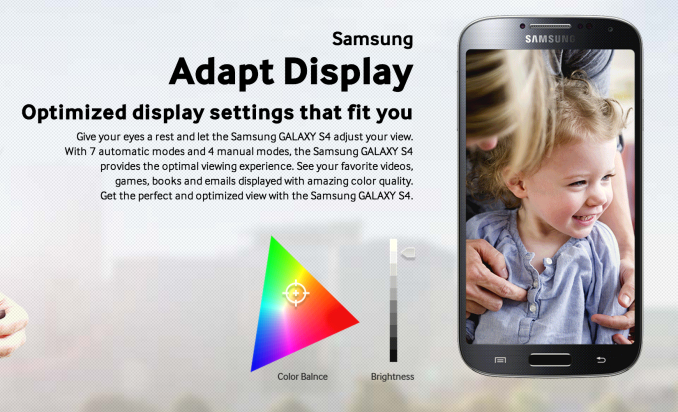




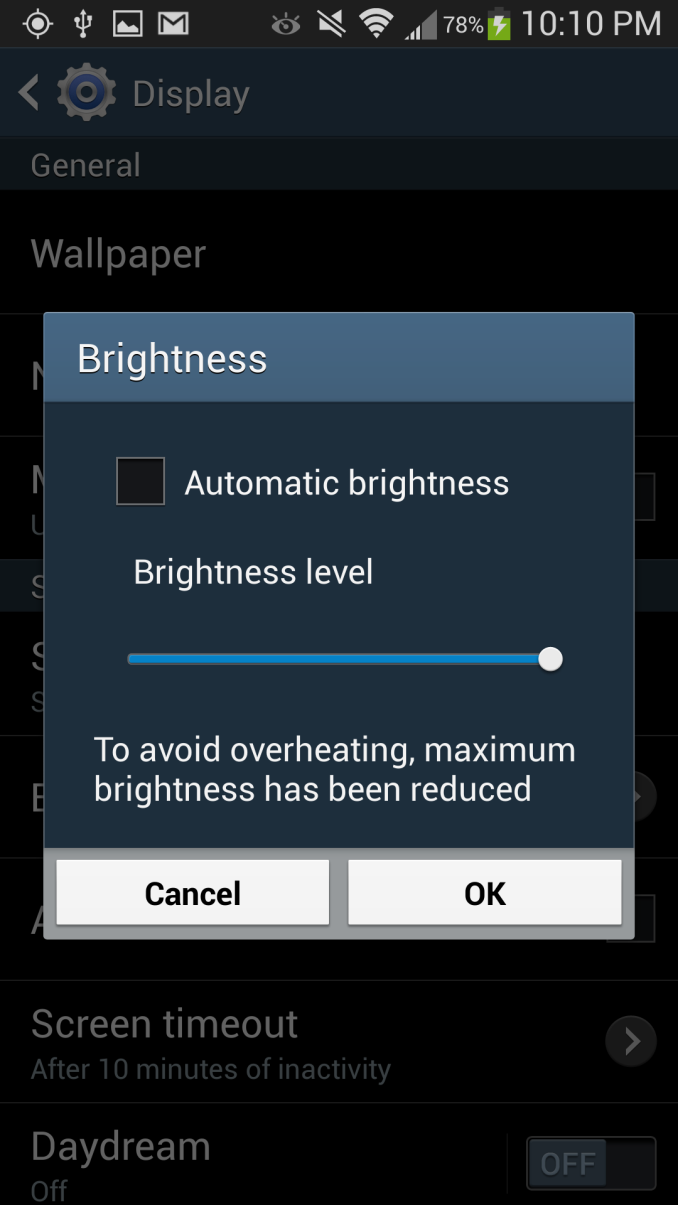
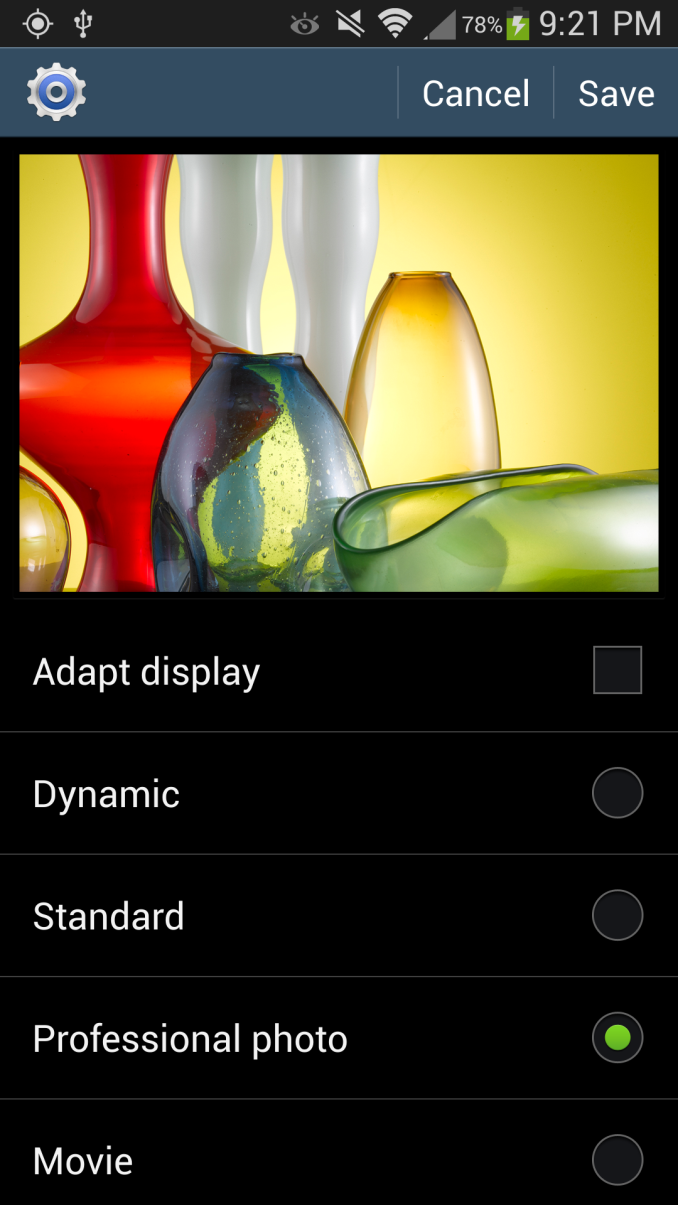
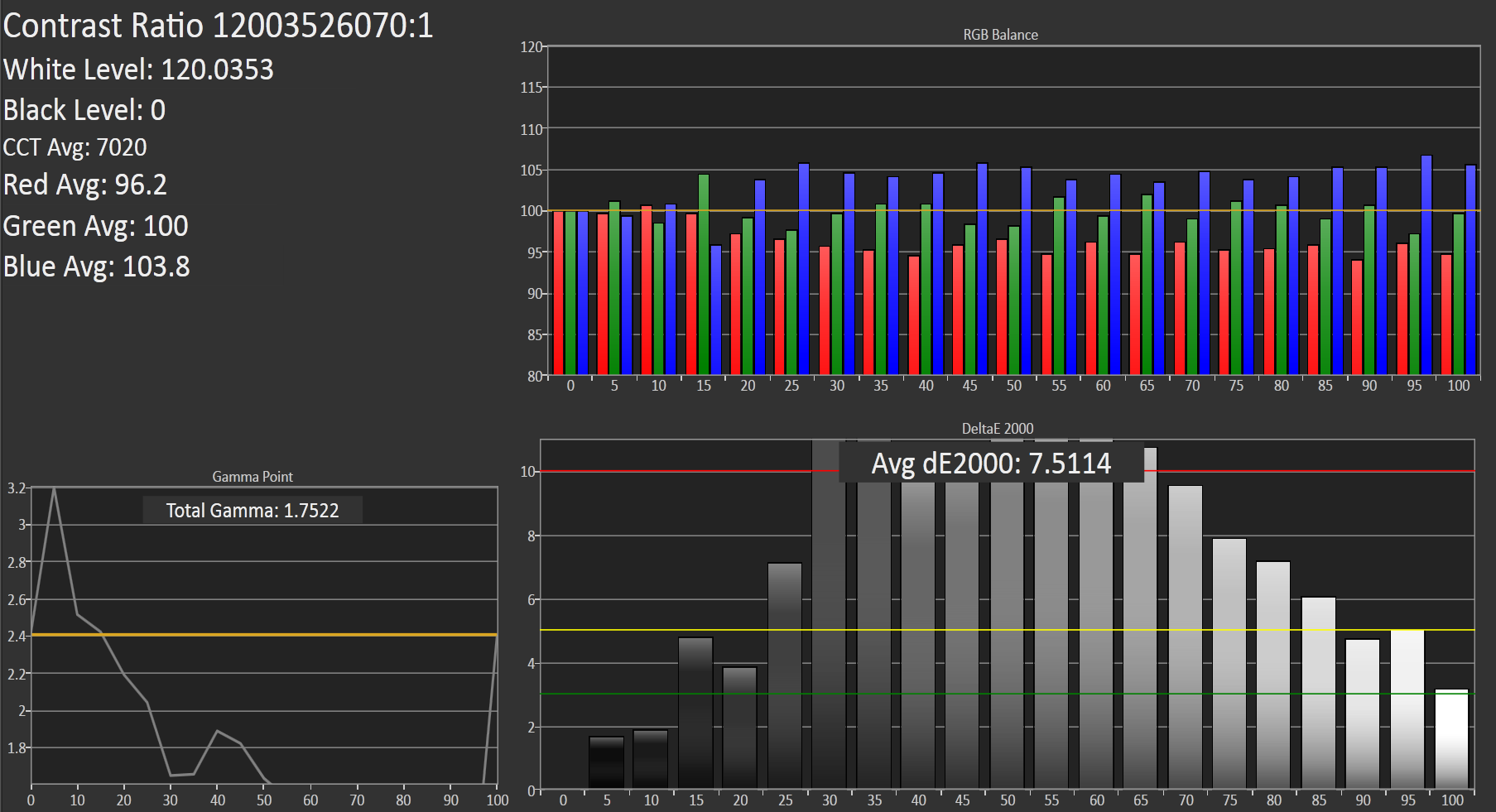








335 Comments
View All Comments
mike55 - Wednesday, April 24, 2013 - link
One of the reasons I am considering the One is because of the camera. 4 MP should be enough for me since I would be viewing it on a 1080p display (2.1 MP) tops. But then I found out the field of view is really large, which would mean I would probably be more likely to crop photos. The images also aren't very impressive in good lightning conditions. It almost looks like it would be a downgrade from my iPhone 4 in terms of photos taken with good lightning. Of course the low light shots would be much better on the One.With the GS4, it feels like the camera is an upgrade in every way, and not just some ways, from my current phone. That, the larger screen, and the fact that the screen is OLED is pushing me towards the GS4. Still conflicted though, haha.
UpSpin - Wednesday, April 24, 2013 - link
I agree, 4MP should be enough, but is the lowest acceptable size. 6MP or maybe 8MP would have been better and safer.The HTC One photos in this review seem to be very blurry and poor compared to the same photos taken for the HTC One review:
http://images.anandtech.com/reviews/gadgets/HTC/HT...
http://images.anandtech.com/reviews/gadgets/Samsun...
I don't know what happened.
The field of view is large, which normally is an advantage, especially indoors. But you're right, outdoors, with the lower resolution it might be an issue.
Regarding OLED: I wrote it in another comment, too. I own a HTC Desire with one of the first OLED screens for smartphones. But also have access to a Galaxy Note with OLED. The colors are stunning, but just false. The max. brightness is poor compared to LCD, so outdoors it becomes more difficult too see the content. OLED consumes more power displaying bright objects (webpages), so much shorter battery life. The sub-pixel size is smaller which shouldn't be an issue any longer at such a high resolution and it also doesn't have pen-tile. The real advantage is that black is almost 100% black which is great :-) The disadvantages however are huge, and while I still like OLED technology and also use simpler OLED displays in my own projects, I think it's just inferior to LCD in smartphones right now. (see this review highlighting some issues). But the screen is larger, another advantage for the S4. Sad that the One has such a huge bezel.
Silellak - Wednesday, April 24, 2013 - link
The difference is likely that the camera was set to default or -1 Sharpness in the original HTC One photo and -2 sharpness in this review.gnx - Wednesday, April 24, 2013 - link
If my memory is correct, the OLED in HTC Desire was from CMI, not Samsung, so I'd think slightly inferior. That said, from all I can gather, AMOLED is still a technology in progress, each generation better than the last, though still with some trade-offs compared to the much more mature LCD. If there is one console, Samsung leads the OLED development, with it's Super AMOLED screens, so if you decide to stick to OLED, at least you know you're getting the best OLED out there with the SGS4.nerd1 - Wednesday, April 24, 2013 - link
4MP is not enough, unless the sensor is Foveon.DroidTomTom - Wednesday, April 24, 2013 - link
Button layout. That is my biggest gripe with the HTC One. The power button should never be on the top. I hated it on my Palm PDAs and on every smartphone I have had since. My Galaxy S has a button layout that just works.creathir - Wednesday, April 24, 2013 - link
Brian, the HTC's audio is flat out amazing.How is the audio on the GS4?
Are you planning on doing audio tests in the future? I know compared to my iPhone 5, the One blows it completely out of the water.
Toss3 - Wednesday, April 24, 2013 - link
Are you talking about headphone performance or external speakers?creathir - Wednesday, April 24, 2013 - link
External speakersscaramoosh - Wednesday, April 24, 2013 - link
How is plastic a downside? It's much better than dented scratched up metal that you'll have to wrap in a plastic case to protect it anyways. Just find it funny how the only two times people see their metal phones is when they buy it and when they sell it, the rest of the time it's in a stupid case. Having to buy a case alone is proof that metal isn't a good material for a phone.I dropped my Nokia, what did I do? Bought a new back cover, replaced it. What will I do with the One if I did the same? Oh, I'm fucked unless I want to pay HTC hundreds to fix it and be without a phone for a month.